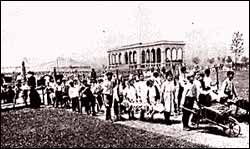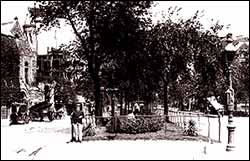Playgrounds and Public Recreation (1898–1929)
1898
The same year that the boroughs of New York were consolidated, the Outdoor Recreation League was formed by Charles B. Stover and Lillian D. Wald. This independent advocacy group provided slides, seesaws and professional play leaders for neighborhood playgrounds. The playgrounds were located in small parks in slum districts, such as Seward and De Witt Clinton Parks, which were now being acquired by the Parks Department through the 1887 Small Parks Act.
1902
Reform candidate Seth Low was elected mayor. Reform politicians like Low felt the city should take an active role in building and operating playgrounds. He appointed William R. Willcox Manhattan park commissioner, and the Parks Department immediately assumed responsibility for the nine playgrounds that had been started since 1898 by the Outdoor Recreation League. Parks Department designers, including landscape architect Samuel Parsons, Jr. and architect Arnold W. Brunner, drew up plans for the permanent improvement of these playgrounds with recreation pavilions, running tracks and outdoor gymnasia. The first Parks Department recreation programs were also started. A kindergarten and gymnasium were opened in Hamilton Fish Park, and in De Witt Clinton Park the first "Children's Farm Garden" was established.
1903
In October 1903 Seward Park, the first municipal park in the country to be equipped as a permanent playground, was dedicated. Seward Park became the model for similar playground developments at Thomas Jefferson, De Witt Clinton, St. Gabriel's (St. Vartan), East River (Carl Shurz) and Mulberry Bend (Columbus) Parks.
1906
The Playground Association of America (later the National Recreation Association) was founded in 1906. Groups like the Playground Association asserted the new social roles for parks, calling for increased active recreation facilities in city parks across the country.
1910
After a brief return to Tammany Hall politics under mayor George B. McClellan during which no new playgrounds were built, reformer William J. Gaynor was elected Mayor in 1910. Gaynor appointed Charles B. Stover, co-founder of the Outdoor recreation League, as Manhattan park commissioner. Stover, already revered as the "Father of Seward Park," organized the first Bureau of Recreation in the Parks Department, and increased the number of playgrounds. By 1915, nine playgrounds had mushroomed to 70. The Parks Department sponsored athletic competitions and football and baseball leagues that involved thousands of boys. Girls' activities included folk dancing, arts and crafts, and enormous costume pageants.
1911
Samuel Parsons, Jr., Calvert Vaux's successor as Parks Department Landscape Architect, retired in 1911 in a dispute with Commissioner Stover over the deleterious effect of recreation programs on Central Park's lawn areas. From this point on, the maintenance of Central Park's landscape suffered a decline, and the recreational needs of the city took ever greater precedence over the preservation of the 19th century park.
A park commissioner was named solely for the Borough of Queens in 1911. Since 1898 Queens had increased its total acreage of parks to 688 acres, including about 500 acres of Forest Park. In 1912, the year the Queens Parks Department moved into the new Overlook Building in Forest Park, over 300 acres of parks were acquired in that borough for a total of over 1,000 acres.
1920
A park commissioner was first named for Staten Island. Now five commissioners, one for each borough, governed the decentralized Parks Department. The Manhattan commissioner continued to serve as president of the Park Board, made up of the five commissioners.
Economic boom following World War I led to increased residential development of New York's boroughs. The population of Queens had already doubled between 1910 and 1920. New parks acquired there in the 1920s included Cunningham Park (350 acres) and Alley Pond Park (654 acres). Staten Island was also anticipating intense residential development; Clove Lakes (195 acres), Wolfe's Pond (317 acres) and La Tourette (550 acres) Parks were all acquired in the 1920s.
1927
The "Merkel Report" on Central Park was completed in 1927 by landscape architect Hermann W. Merkel. The report documented a general decline in the condition of the park and made a series of important suggestions for its future maintenance. Merkel was the first to suggest the installation of playgrounds near park entrances, and benches set in concrete footings along pedestrian paths.
The William T. Davis Wildlife Refuge was established on Staten Island in 1928; it was the first wildlife refuge in New York City.


